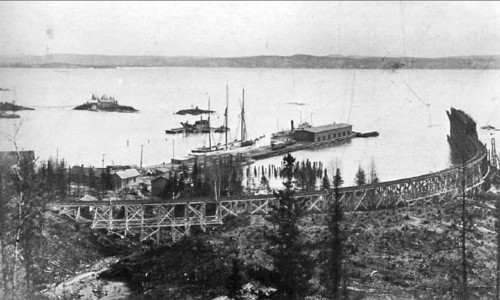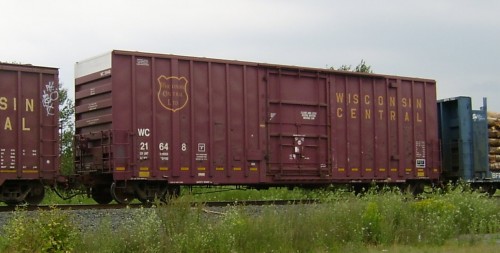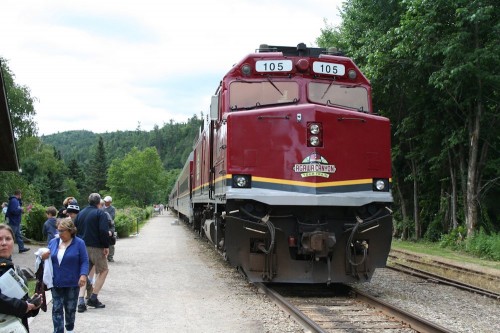AC 8016 at Steelton yard in August 1997. Photo courtesy Blair Smith.
Iron ore and coal traffic on the Michipicoten subdivision
In the late 1890s industrialist Francis Clergue was building his business empire in Sault Ste. Marie when in 1898 a prospector brought a lump of ore to the attention of Clergue’s company and the rest, as they say, is history – albeit one with its share of bumps and bruises along the way and not necessarily a happy ending.
Early Years
In response to the ore discovery, in 1899 Clergue chartered the Algoma Central Railway and built a twelve mile line from a harbour at Michipicoten to the newly established Helen mine, a few miles northeast of what is today Wawa. Another mine (Josephine) was established a couple years later several miles further east. The harbour at Michipicoten featured a large 275′ wooden ore dock with a 600 ton capacity and a long curving approach trestle, as well as a 600′ commercial pier with a large warehouse and passenger station. Steel ore cars built in 1899-1901 were acquired new from the Pressed Steel Car Co. in Pennsylvania.
Within a few years however, cracks began to appear in the ACR’s parent company, the Lake Superior Corporation, and in 1903 Clergue’s empire suffered a spectacular financial crash. Most iron mining activities came to a stop and Helen mine was abandoned. Not much happened on the Algoma Central for the next several years, with the railway and other various companies in the Lake Superior Corporation family entering a slow period until about 1909.
In 1909-1910, fortunes took a turn for the better. Construction was restarted on the main line from where it had been abandoned in 1903 some 70 miles north of the Sault, and by 1914 had been completed to Hearst. The line to Josephine mine was rebuilt and extended towards what would become Hawk Junction, and a new 9 mile long spur was built in 1910 from a point between Wawa and Josephine to access the new Magpie mine. The ore at Magpie was lower grade than what was mined at Helen, and extensive ore processing facilities were constructed at the mine to upgrade the ore. While Josephine mine seems to have never truly amounted to much, Magpie mine was a strong source of traffic for several years and additional steel ore cars were purchased secondhand from the Duluth & Iron Range Railway in 1916. Also in 1910, an pyrite mine was established by Madoc Mining near Goudreau, north of Hawk Junction with product shipped to the harbour at Michipicoten – mainly in wooden ore hoppers assigned to this service.
Ultimately however, Magpie shut down in 1921 bringing an end to iron mining in the Wawa region once again, and in about 1925 the pyrites operation at Goudreau also shut down. Through the rest of the 1920s the railway would be sustained by pulpwood revenues.
Coal and Fuel
In 1929 the remains of the abandoned ore dock were removed and replaced by a large coal dock with a travelling unloading bridge structure to unload coal from bulk freighters. The majority of the coal brought in to the port would be loaded in CN cars to be shipped to various northern Ontario terminals for locomotive fuel. This traffic would keep the port quite busy and in 1943 the dock was significantly expanded.
Dieselization during the 1950s was the death knell for coal being handled via this port, and the traffic declined throughout this decade, eventually ending some time in the 1960s at which point the coal handling equipment was removed. A small Imperial Oil tank farm was built at the habour in the early 1950s to bring in diesel fuel via tanker vessel which maintained some fuel traffic, but a few tank cars was a far cry from train loads (literally) of coal.
The Return of Iron Mining
In the late 1930s, Algoma Steel began an aggressive expansion and bold moves were made to redevelop the mines in the Wawa area. In 1939, nearly 20 years since that last ore had previously been mined in the area, the mine at Helen was redeveloped and a new ore processing plant was constructed at Wawa. Raw ore was shipped from the mine(s) to the sinter plant, and the processed ore was shipped either by rail to Sault Ste. Marie or to Michipicoten harbour where a large new unloading trestle and loading equipment were built to load ore into lake freighters. Large numbers of steel hoppers were acquired secondhand from various roads in the United States, the railway’s old fleet of 1900-built ore cars being long gone, and would have been massively obsolete anyway by then.
Then in that same year Hitler’s Germany invaded Poland, and suddenly a resource hauling railway serving a steel mill became a rather hot property indeed. (It’s entirely possible that the politically savvy head of the Algoma Steel Company, Sir James Dunn, may have anticipated the conflict in attempting to redevelop the Wawa mining industry from 1937-39.) The boost that the wartime revenues gave the railway carried through after the end of the conflict with the railway continuing strong through the 1950s and 1960s. In the early 1960s the principal amount on the construction bonds to build the railway was finally paid off and the company paid a dividend to shareholders for the first time in its entire history.
During the early 1940s an attempt was made to redevelop the old Josephine mine as well, with work begun in 1941 on draining a lake and sinking new underground mine shafts. Ore began shipping out of the mine in 1945, unfortunately soon after a collapse of large section of the mine brought a final, permanent end to the works at Josephine. Other mines were developed though, such as the open pit Sir James mine, reached via the three and a half mile Siderite spur and operating through the 1950s.
During the 1950s facilities at the Helen mine were significantly upgraded, with a new underground mine shaft being developed at the site (The George A. MacLeod mine). A bucket tramline had been built in the 1940s or early 1950s to carry raw ore from the mine to Wawa and this was replaced later with a high capacity conveyor system that brought the ore directly from the underground MacLeod mine to the sinter plant. The unloading trestle at Michipicoten harbour was also upgraded in the 1950s to a conveyor system from a dumping pit for the railcars.
An indication of the importance of the facilities at Michipicoten during the 1950s is that the railway built new diesel locomotive servicing facilites at Brient (the yard for the harbour, just under a mile up the hill), although by the 1970s ore was shipped to Algoma Steel entirely by rail year-round, and the ore handling facilities, as well as the coal dock, the old commercial dock (as pulpwood shipments also switched to an all-rail basis in the late 1950s) and the Brient yard were all abandoned. (The old ore trestle doesn’t seem to have been actually demolished until the late 1980s.)
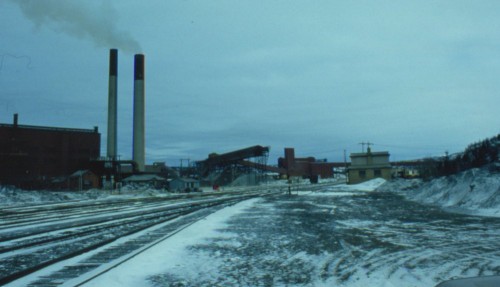
March 1981 view of Wawa yard. The main sintering facilities are to the left. The structures in the centre of the photo are part of the conveyor system that delivers ore from the mine to the plant, and the buff coloured building at right is the ACR station. Photographer unknown, slide in my collection.
In the early 1970s however, some new traffic began using the former coal dock at Michipicoten: limestone, deposited by self-unloading vessels, would be shipped to Wawa for blending with the sinter. Coke and even some additional grades of iron ore for blending with the Wawa ore were also handled via Michipicoten harbour through the 1980s and 1990s.
During the late 1990s however, Algoma Steel began switching over to using higher grades of iron ore mined in the Michigan Upper Penninsula, and in 1998 the mine and sinter plant at Wawa closed down, bringing a final? end to iron ore mining in the area, at least for now. With the sole source of traffic on the branch eliminated, the railway filed for abandonment of the line, and in 2000 the tracks from Hawk Junction to Michipicoten were removed.
Usage and Restrictions on 6 Axle Power on the ACR
In 1971 the ACR received what was to be their first order of modern, “second generation” diesel locomotives. In a marked departure from the smaller four axle 1500 and 1750 HP GP7 and GP9 units that comprised the motive power fleet at the time, the ACR ordered a trio of 3000 HP, six-axle SD40 locomotives from General Motors Diesel Division. This order was followed up two years later with six SD40-2 units in 1973.

AC 180, the road’s first SD40, at Steelton yard in Sault Ste. Marie. March 1981. Slide in my collection.
The large size and weight of these modern units, combined with the long rigid wheelbase of the three-axle trucks underneath raised some concerns about increased track wear and maintenance as a result of their use – similar concerns had largely restricted the use of the ACR’s largest steam locomotives, a pair of rather heavy 2-10-2 (most of the ACR’s freight engines were of a 2-8-2 wheel arrangement). However, unlike the steamers, which were just a little too big for the railway, the SD40 and SD40-2 units were massively successful in hauling heavy ore trains between Wawa and Steelton yard, so these concerns were muted or just chalked up to the cost of doing business.
This is not to say that the big units didn’t have certain restrictions placed on them. The employee’s timetables list numerous special speed restrictions when the SD40 type units are used in a diesel consist, mainly in areas with sharp curvatures. In many places these restrictions are 5 to 10 MPH lower than the standard freight speed limits for those zones, and speeds in passing sidings was restricted to a maximum of 12 MPH (where the normal legal maximum for Restricted or Slow speed was 15 MPH).
Additionally, while no prohibition exists in the timetable, most sources tend to suggest that the use of the larger units was discouraged north of Hawk Junction – particularly north of Oba where the mainline was mostly 80-85lb rail, much of it original from 1912, so train nos. 5 and 6 would typically be run with smaller 4-axle power, with the big SD40s earning their keep hauling tonnage between Steelton and Hawk Junction, and on the Michipicoten branch ore trains.
Interestingly, today CN runs freights on the line up into Hearst with even larger typical modern power like SD70 type locomotives, although I’m not sure if the rails have been materially upgraded. Probably just significantly speed restricted.
Freight Car Friday #52 – WC Paper Boxcars
Photographed at Sault Ste. Marie in August 2004, WC 21648 is a typical example of the modern high-capacity 50′ boxcar design built for paper service. This particular car is part of series WC 21550-21649 built by Greenbrier’s Trenton Works in 1997.
The second car coupled to the left of 21648 is WC 26010, an older ex-SOO Line car also commonly still in paper service at the time. Both of these types of cars would have been the typical sight at the St. Marys Paper mill during the 1990s and 2000s.
Passenger Operations
Regular Service
Regular passenger service on the ACR was provided by train nos. 1 and 2 from Sault Ste. Marie to Hearst (and vice versa).
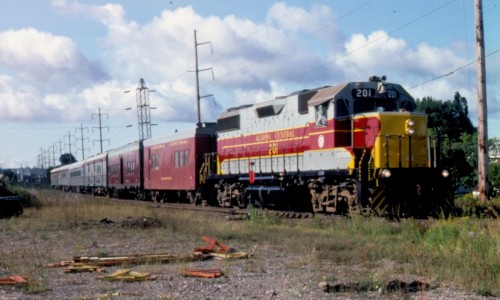
Northbound no. 1 at the north end of Steelton yard, departing for Hearst with GP38-2 201 in the lead, Sept. 7, 1983. Francis J. Wiener photo in my collection.
In the 1980 timetable, no. 1 was scheduled to depart Sault Ste. Marie at 9:30 am daily except Mondays (with no. 2 therefore running daily except Tuesdays) in the summer timetable, and only Fridays through Sundays (Saturday to Monday for no. 2) an hour earlier at 8:30 am in the fall/winter timetable.
If you turn back the clock a bit to the 1950s-1960s, passenger service was also included on the Michipicoten subdivision, and nos. 1 and 2 were actually daily excluding Sundays between Sault Ste. Marie and Michipicoten, connecting with trains 3 and 4 to/from Hearst at Hawk Junction. (Although in the late 1940s to early 1950s, three days a week this ran instead as Mixed (freight and passenger) trains 5 and 6. If you go far enough back in history, all passenger service was in mixed trains.) Passenger service on the branch was discontinued in the mid 1960s when Trans-Canada Highway 17 was completed through the area.

The last northbound passenger train to leave Hawk Junction prepares for departure. July 13, 2015. My photo.
In more current times, CN continued to operate the regular passenger service (as trains P631 and P632) until early 2015, when for funding and political reasons the service was undertaken by a new operator (Railmark) which unfortunately – again, due to financial and political complications – was not successful and passenger service was terminated in July of 2015. As of this writing, local stakeholder groups are searching for and negotiating with potential new operators to try to save the service.
Tour Trains
In the 1950s, recognizing the scenic beauty of the Canyon and the tourist potential, the Algoma Central Railway established the privately owned Agawa Canyon Park and developed the location as a destination for a day trip tour out of Sault Ste. Marie on the “Agawa Canyon Tour Train”.
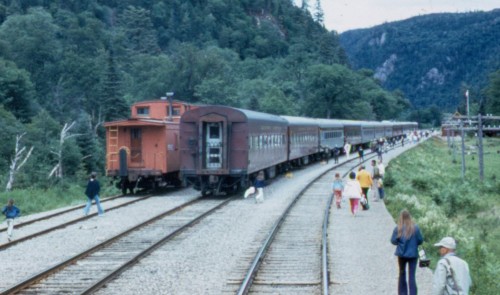
Tour train coaches dropped off by no. 1 at Canyon, July 3, 1972. R.J. Schwenk photo in my collection.
Some of the older coaches were upgraded with modified steps for easy de-training of passengers at the siding and service started out with regular train no. 1 dropping off a dining car and a coach or two in the siding to be picked up later by the southbound no. 2. This service grew in popularity throughout the 1960s with more and more cars being regularly set off in the siding at Canyon. By the early 1970s so many cars were being used in the Agawa Canyon Tour Train service that an extra train was run to exclusively handle the tour cars for Canyon. By the mid 1970s, it was permanently added as a regular daily train (nos. 3 and 4) in the summer timetable. Also from 1969 to 1974 “new” passenger cars were acquired to expand and replace the existing fleet, with coaches, baggage cars and dining cars acquired secondhand from such roads as Canadian Pacific, Central of Georgia, Southern Pacific, Santa Fe, Illinois Central, Union Pacific, and Denver & Rio Grande Western.
Equipment for the tour train service was upgraded again in the early 1990s with cars acquired from VIA Rail, and most recently in 2009 with the purchase of the Rio Grande Ski Train from Denver, Colorado. The Agawa Canyon Tour train still operates on a daily basis during the summer as CN P633 (for the entire round trip).
The long term future of the train is however uncertain as CN has been indicating they are not interesting in being in the passenger business. The original plan when Railmark assumed operation of the regular passenger service was for them to eventually operate the tour train as well; with the new search for another replacement operator, the idea as I understand it would again be to have that operator take control of all passenger service.
Somewhere around the late 1970s the railway also began running a weekend-only fall/winter version of the tour train service, with tour coaches being exchanged by regular trains no. 1 and 2 at Eton, without the stopover at Canyon park. In the 1990s and early 2000s the “Snow Train” ran as a separate train in its own right, still running through the entirety of the canyon and turning at Eton. This train has not run in several years now.


